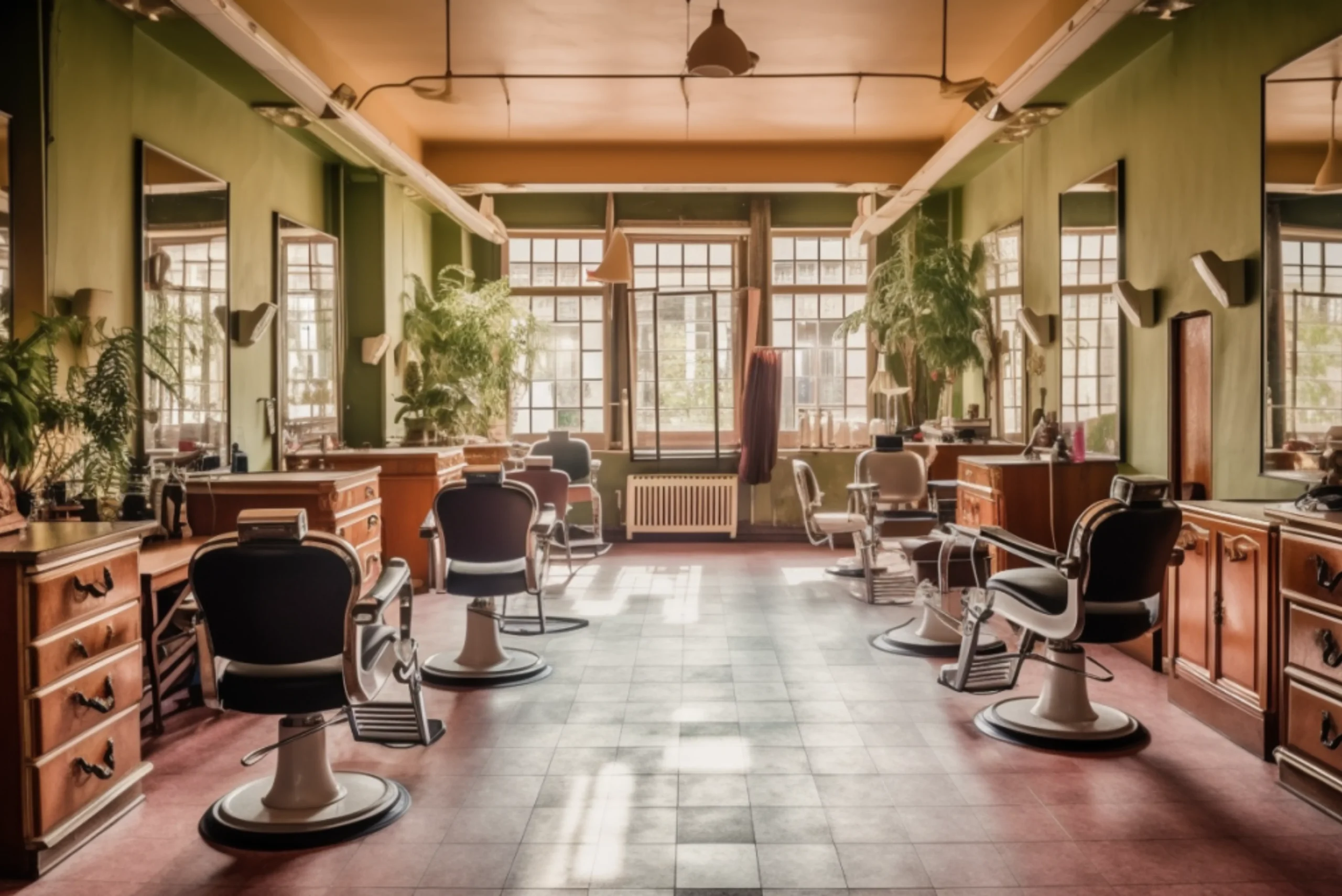Table of Contents
ToggleStep by Step Guide to Establishing and Managing a Profitable Beauty Salon
How Can I Get My Own Beauty Salon? Running a beauty shop involves more than simply doing cosmetics and hairstyles; it involves designing an environment where people may feel more confident and beautiful. The need for expert grooming services is rising, which is driving the beauty salon industry’s success. We’ll go over the crucial procedures in this post to assist you in starting and operating a profitable beauty shop.
What Qualifications Do You Need To Open A Beauty Salon
Depending on the laws in your area, you may need to fulfill a number of certifications and criteria before opening a beauty shop. The following are typical requirements and actions you would need to take:
Cosmetology License: Cosmetology licenses or related certifications are often needed for salon owners and employees. Usually, this entails finishing a cosmetology curriculum that has been recognized by the state, which includes subjects including hair style, skincare, nail care, and sanitation procedures. To legally practice cosmetology, graduates of the curriculum need to pass a license test.
Business License: In order to legally run a salon, you probably need to have a business license or permission. This entails registering your company with the relevant county or municipal clerk’s office, among other local government agencies. Depending on where you live, there are different criteria for getting a business license in different places.
Salon Insurance: To guard against property damage, liability claims, and other unanticipated events, your salon must be insured. General liability insurance, property insurance, workers’ compensation insurance, and professional liability insurance—also referred to as malpractice insurance—are common forms of insurance for salons.
Health and Safety Standards: In order to protect the health and safety of your employees and customers, you must abide by certain standards and regulations. This entails upholding hygienic and sanitary standards for the instruments and equipment used in the salon, keeping a clean and hygienic atmosphere, and abiding by health laws for chemical and skincare procedures.
Strong business management abilities are necessary for operating a profitable salon. These abilities include marketing, personnel management, financial management, and customer service. Formal schooling or training in business management is not always necessary, but knowing the foundations of business can help you run your salon more successfully and expand it.
Continuing Education: New trends, methods, and technology are always being introduced in the beauty business, which is a field that is always changing. Continued education and professional development are crucial if you want to maintain your competitive edge and provide your customers the finest care possible. To acquire new skills and remain current with industry trends, this may include going to workshops, seminars, trade exhibitions, or online courses.
Research and Planning on How To Own a Beauty Salon
It’s essential to do extensive study before entering the beauty salon industry. Examine the market to learn about the competitors, prevailing trends, and prospective clientele. Determine the tastes of your target audience. Furthermore, choosing the ideal site is crucial as it will have a big influence on your salon’s performance.
Market Analysis: To comprehend the dynamics, trends, and prospects of the beauty business, market analysis entails investigating and assessing the sector’s landscape. It include researching customer behavior, rival analysis, market size, and growth potential. Salon operators may find niche markets, service gaps, and possible opportunities for industry expansion by doing a complete market study.
Selecting the Target Audience: Selecting the perfect customer for the beauty salon involves establishing the ideal clientele’s precise demographics, interests, and qualities. In this procedure, the market is segmented according to variables including age, gender, economic bracket, way of life, and preferences for physical attractiveness. Salon owners may better cater their services, marketing campaigns, and customer experiences to the wants and tastes of their ideal clientele by having a thorough grasp of their target demographic.
Location scouting: This process include investigating and assessing possible sites for the beauty parlor. Foot traffic, accessibility, visibility, parking availability, nearby companies, and the area’s demographic makeup are all important factors to take into account. The objective is to choose a prime site that complements the salon’s ambiance and identity, increases exposure to the target demographic, and offers customer convenience.
Business Plan Development
The success of your salon is built on the creation of a thorough business strategy. Describe the services you plan to provide, including spa treatments, skincare products, coloring, styling, and haircuts. Establish your price plan so that you can maintain profitability and a competitive edge. To direct the operations of your organization, create a thorough budget and financial predictions.
Defining Services Offered:
Determining the variety of beauty treatments and services the salon will offer its clientele is part of defining the services provided. This covers, among other things, spa services, nail care, styling, coloring, haircuts, and skincare. Based on consumer demand, the tastes of their target market, and the staff’s level of experience, salon owners should choose their services wisely. By providing a wide range of services, the salon may draw in more customers and become more competitive in the industry.
Pricing Methodology:
A pricing plan describes how the salon will determine the cost of its services in order to turn a profit and maintain its position as a market leader. A few things to think about include labor and material costs, overhead costs, competitive pricing, and consumers’ perceptions of value. Salon owners have a variety of price options to choose from, including tiered pricing depending on treatment difficulty or length, package pricing, and à la carte pricing.
A balance between the salon’s profitability and customer affordability should be achieved in the pricing plan. These pricing factors are vital in figuring out How Much Does It Cost To Open A Salon as they guarantee that the company will make enough money to pay bills and turn a profit while providing clients with competitive, appealing prices.
Estimating finances and creating a budget:
Making a financial plan that details expected income and out-of-pocket costs for the salon’s operations over a certain time frame—usually a year—is the first step in budgeting. This covers both variable costs like supplies and marketing expenditures as well as fixed costs like rent, electricity, and payroll. Financial forecasts use past data, industry trends, and growth estimates to predict the salon’s future financial success. In order to secure the long-term viability of the salon, these predictions assist salon owners in making well-informed choices about the distribution of resources, potential investments, and financial management techniques.
Legal Considerations
For every organization, ensuring legal compliance is crucial. Register your salon and make sure it has all the licenses and permissions it needs to operate lawfully. Invest in insurance coverage as well to shield your company from unanticipated events like property damage or liability lawsuits.
Getting the Business Entity Registered:
Whether the salon is a corporation, limited liability company (LLC), partnership, or sole proprietorship, the legal structure of the business must be formally established via registration. Typically, this procedure entails registering the company name, acquiring a tax identification number (TIN) or employment identification number (EIN), and submitting the required documentation to the relevant federal, state, and local government agencies. By registering the business entity, the salon owner(s) are protected from responsibility and may be assured of compliance with legal rules.
Getting Authorizations and Licenses:
In order to lawfully operate a beauty salon and maintain compliance with industry norms and health standards, licenses and permissions must be obtained. Depending on the services provided and the salon’s location, different licenses and permissions may be needed. In Lakeland, Florida, common licenses and permissions for beauty salons include business licenses, zoning permits, construction permits, health permits, and licenses for cosmetology practitioners. Salon owners need to make sure they have all the licenses and permissions they need in order to prevent any fines, penalties, or legal problems down the road.
Fulfilling Insurance Prerequisites:
In order to comply with insurance regulations, the salon must have sufficient insurance coverage to shield its assets, staff, customers, and clients from various risks and liabilities. The most important insurance plans for a Walmart beauty salon in your area can include business interruption, property, workers’ compensation, professional liability (sometimes called malpractice), and general liability. Salon owners should evaluate their unique insurance requirements in light of the salon’s size, services provided, location, and staff count. Salon owners may reduce their financial risks and feel secure knowing that they have full insurance coverage.
Interior Design and Setup
Your salon’s atmosphere has a big impact on drawing in and keeping clients. Make an investment in furnishing, decorating, and lighting to create a cozy and inviting space. Create practical workstations that maximize personnel space and productivity.
Creating a Welcoming ambiance: Creating a welcoming ambiance at a salon entails making patrons feel at ease, at ease, and pampered from the minute they walk in. This entails choosing calming color palettes, delicate lighting, and hospitable décor accents like artwork, plants, and accent items. Adding cozy sitting sections, soothing music, and enticing aromas may improve the atmosphere overall and improve the customer experience.
Choosing Furnishings and Decor: Choosing furnishings and ornamental accents that go well with the salon’s concept, branding, and intended aesthetic is the process of selecting furniture and decor. This entails choosing aesthetically pleasing and practical salon chairs, styling stations, shampoo units, reception desks, and storage options. Choosing décor pieces like mirrors, wall paintings, carpets, and window treatments may give a beauty
salon in Lakeland, Florida individuality and character while coordinating the overall design.
Planning Workstation Layouts: In order to maximize space, productivity, and efficiency, salon furniture, equipment, and workstations must be arranged intelligently. This entails taking into account elements like traffic flow, accessibility, and ergonomic design to guarantee a pleasant and useful workstation for customers and salon employees. Salon owners may increase productivity, reduce clutter, and provide a seamless experience for both clients and staff by carefully designing workstation arrangements.
Staffing
Hiring competent and affable employees is essential to provide your customers with top-notch service. Establish rigorous hiring procedures to choose competent experts who share the ideals of your salon. Give them continual opportunity for training and development to improve their abilities and guarantee a constant level of service quality.
Employing Eligible Workers:
Hiring competent staff entails finding and choosing people who have the knowledge, expertise, and credentials needed to carry out their jobs in the salon in an efficient manner. This entails doing in-depth interviews, going over portfolios and resumes, and evaluating the technical and social abilities of applicants. To make sure that they make a good contribution to the success of the salon, salon owners should look for applicants that exhibit professionalism, originality, and a love for the beauty business.
Putting Training and Development Plans Into Practice:
Putting training and development plans into place entails giving salon employees opportunity for continual learning and skill improvement in order to improve their performance and career advancement. Offering training sessions, lectures, and certification courses is one way to help people advance their technical knowledge, pick up new skills, and keep abreast of market developments. A beauty salon in Lakeland, Florida that offers professional development, coaching, and mentoring programs encourages a culture of lifelong learning and personal development among its staff members.
Creating Policies and Procedures for Employees:
In order to regulate staff behavior, performance, and conduct inside the salon, it is necessary to establish clear guidelines, regulations, and expectations via the establishment of employee policies and procedures. This involves providing guidelines for professional behavior, client contacts, dress code, attendance, and confidentiality.
Consistency, effectiveness, and professionalism in salon operations are ensured by establishing explicit protocols for duties including appointment scheduling, maintaining inventory, and responding to customer complaints. Maintaining a good work environment and maintaining the salon’s reputation for excellence may be achieved via consistently explaining and implementing these rules.
Marketing and Promotion
Developing a strong online presence for your business is crucial to drawing clients to your salon. Create a distinctive brand identity and communicate it using your signs, logo, and marketing collateral. To successfully reach your target demographic, use offline and online marketing techniques including email campaigns, social media, and local advertising.
Developing a Distinctive Brand Identity:
Developing a distinctive brand identity for a salon is figuring out what makes it stand out from the competition and appeal to the target market.
Creating a distinctive salon name, logo, and graphic components that express the brand’s style and values are all part of this process. Furthermore, creating a unified brand voice and message across all marketing platforms fosters customer loyalty and brand awareness.
Putting Internet and Offline Marketing Strategies into Practice:
In order to reach and attract new clients, the salon must promote its brand, services, and special offers via a variety of channels by putting online and offline marketing techniques into practice.
A user-friendly website, social media audience engagement, focused online advertising campaigns, and search engine visibility optimization via SEO techniques are a few examples of online marketing practices.
Distributing printed materials like flyers, brochures, and business cards is one kind of offline marketing. Other offline marketing strategies include taking part in community outreach programs, sponsorships, and local events.
Creating and Preserving a Faithful Clientele:
Providing outstanding customer service and fostering deep connections with customers are key to attracting and keeping a devoted clientele. These actions also promote customer loyalty and recommendations. This entails providing tailored advice, keeping in mind the preferences of the customer, and going above and beyond to surpass their expectations.
Putting in place customer loyalty programs with incentives for referrals or rewards points may encourage recurring business and long-term loyalty. Furthermore, persistently seeking out client input and attending to their issues shows a dedication to their needs and gradually builds their trust and loyalty.
Client Experience and Satisfaction
Providing outstanding client service ought to be your salon’s first concern. Make an effort to surpass each client’s expectations by providing them with individualized experiences. Strive to get evaluations and comments from your clients in order to enhance your offerings over time and establish enduring bonds with them.
Appointment Scheduling That Works:
The implementation of systems and tools to handle client bookings in a streamlined and structured way is necessary for efficient appointment scheduling. To make it easier for customers to make appointments, this involves using online booking tools or appointment scheduling software.
In order to guarantee seamless operations and raise client satisfaction, scheduling procedures should be optimized to reduce downtime and make the most use of salon resources, such as personnel availability and treatment rooms.
Managing Inventory Efficiently:
Keeping precise records of salon supplies, goods, and equipment is essential to effectively managing inventory in order to guarantee sufficient stock levels and reduce waste or shortages.
This entails carrying out routine inventory audits, keeping tabs on product expiry dates and consumption, and restocking supplies as required. By putting inventory management methods and procedures in place, salon owners may maximize inventory turnover, save expenses, and enhance overall resource management effectiveness.
Managing Accounting and Financial Transactions:
In order to preserve financial health and compliance, handling accounting and financial transactions requires precisely tracking and controlling salon revenues, costs, and financial transactions.
This entails taking a variety of payment options, including cash, credit cards, and electronic payments, and making sure that every transaction is properly documented. Additionally, efficient financial management and decision-making are facilitated by keeping well-organized financial records, resolving accounts, and routinely creating financial statements.
Salon operators may guarantee compliance with tax legislation and reporting requirements while streamlining financial procedures by using professional accountants or using accounting software.
Delivering Outstanding Customer Service Experiences:
Delivering top-notch services and individualized attention to customers in order to surpass their expectations and make a lasting impression is part of providing excellent service experiences. This entails giving them a kind welcome, paying attention to their wants and requirements, and offering knowledgeable counsel and suggestions. A great customer experience is mostly attributed to How To Own A Beauty Salon From Home, keeping the salon spotless and welcoming, and guaranteeing professional and polite service.
Requesting Reviews and Input:
Getting evaluations and comments from customers entails proactively asking them about their interactions with the personnel and services provided by the salon. There are a number of ways to do this, including face-to-face interactions, online questionnaires, and feedback forms. Encouraging consumers to provide evaluations and comments enables the salon to pinpoint areas in need of improvement, quickly resolve any issues, and highlight client endorsements to draw in new business.
Building Sustainable Customer Relationships:
Building rapport, trust, and loyalty with customers is essential to maintaining long-term relationships and encouraging recurring business. This entails maintaining contact with customers using specialized channels of communication, such newsletters sent via email, posts on social media, and exclusive deals.
Furthermore, recognizing significant occasions or client preferences, providing special benefits or incentives to devoted patrons, and sincerely thanking them for their ongoing support all contribute to the development of enduring connections and inspire patrons to act as brand ambassadors for the salon.
Managing Operations
Controlling everyday activities with efficiency is essential to the smooth running of your salon. Install dependable scheduling software to manage appointments more effectively. Keep a check on your inventory to make sure you have an adequate amount of supplies and equipment. Maintain correct financial records and regularly assess your finances in order to make informed business decisions.
Setting Up a Meeting:
The efficient management of client bookings for salon services is the responsibility of appointment scheduling. This include planning for staff availability, scheduling appointments using software, and ensuring that salon resources are utilized as effectively as possible. Effective appointment scheduling ensures smooth operations, cuts down on client wait times, and boosts client happiness.
Inventory Control:
Inventory management includes the administration and supervision of salon supplies, equipment, and merchandise. This means maintaining exact records of product use, stock levels, and stock replenishment in response to demand from customers. Effective inventory management makes it easy to save waste, avoid stockouts, and make sure the salon has the materials it needs to service clients efficiently.
Handling Finances and Accounting:
Taking care of money and accounting includes managing the salon’s financial transactions, documentation, and reporting. This includes tasks like preparing financial statements, keeping tabs on receipts and outlays, settling bank account balances, and mailing bills to clients. When salon owners use good financial management, they can keep an eye on business performance, make educated decisions, and adhere to rules.
Changing with the Industry
New trends and approaches are always appearing in the beauty sector, which is always changing. Keep abreast of the most recent advancements in health and beauty to stay relevant to your clientele. To improve the customer experience, think about introducing cutting-edge technologies and providing creative services.
Keeping Up with the Most Recent Beauty Trends:
Keeping abreast of the most recent advancements in the beauty business necessitates doing ongoing research and being current on new trends, inventions, and breakthroughs. This entails keeping up with trade periodicals, going to conferences and trade exhibitions focused on beauty, and participating in online forums and social media groups where beauty trends are exchanged. Salon operators may anticipate and adjust to shifting consumer tastes and integrate current trends into their products in order to draw in and keep customers by keeping themselves updated.
Presenting Fresh Goods and Services:
In order to adapt to the changing demands and tastes of its clientele, the salon must provide new services and products. This might include launching fresh skincare products, hair treatments, or cosmetic improvements in response to market trends or consumer desire. Salon owners may find and implement cutting-edge services and products that set their salon apart and draw in new customers by doing market research, asking clients for input, and working with manufacturers or suppliers.
Including Advances in Technology:
Using technology to improve service delivery, salon operations, and the overall clientele experience is a key component of integrating technological innovations. This might include putting salon administration software into place to handle inventory, schedule appointments, and assess company performance. How to Start a Salon Without Any Funds Using cutting-edge beauty technology may provide customers unique and customized experiences. Examples of these include laser treatments, computerized skincare analyses, and virtual reality hair consultations.
Community Engagement
Getting involved in the neighborhood might help your salon become more known and draw in new clients. Take part in neighborhood activities, support neighborhood projects, and work with nearby companies to increase your brand awareness. Furthermore, giving to charity organizations helps strengthen your relationship with clients.
Taking Part in Community Events and Activities:
By attending or supporting events, fairs, or festivals, one may actively engage with the community by taking part in local events and activities. This gives the salon a chance to advertise its services, build relationships with the community, and raise its profile. The salon may create connections, get word-of-mouth recommendations, and become a vital part of the neighborhood by taking part in community activities.
Working Together with Other Companies:
In order to collaborate with other firms, one must establish alliances or partnerships with like-minded local companies. This might include collaborating on events, offering joint promotions, or cross-promoting one other’s services with spas, shops, or fitness facilities. Through joint ventures, the salon may broaden its clientele, draw in new business, and take use of pooled resources and advertising campaigns.
Endorsing philanthropic endeavors and causes:
Giving back to the community by providing money, time, or resources to help regional nonprofits, charities, or community groups is what it means to support philanthropic causes and efforts. This might include planning charity drives, taking part in fundraising activities, or helping at food banks or shelters in the community. By contributing to charity organizations, the salon upholds its social responsibility pledge, enhances its standing as a kind and considerate company, and promotes goodwill among patrons and the community.
Continuous Improvement
Assess your salon’s performance on a regular basis and pinpoint areas that need work. To keep ahead of the competition and satisfy the changing wants of your clients, make adjustments and introduce new ideas. To promote success and progress, provide yourself and your employees with chances for professional development.
Examining Metrics of Business Performance:
In order to evaluate the overall performance of the salon and pinpoint opportunities for development, business performance metrics analysis include routinely examining financial data and key performance indicators (KPIs). This entails monitoring data on average ticket price, profitability, revenue, and customer retention rates.
Salon owners may identify strengths and weaknesses, get insights into their company operations, and make well-informed choices to maximize performance and accomplish strategic objectives by examining these indicators.
Putting Strategic Changes into Practice for Growth:
A proactive approach to spotting chances for development, innovation, and enhancement in the salon’s services and operations is necessary when putting strategic changes for growth into practice.
This might include starting fresh marketing campaigns, releasing fresh goods or services, branching out into untapped areas or demographics, or increasing operational effectiveness. Salon owners may position their company for long-term development, adjust to changing market trends, and remain ahead of the competition by embracing change and putting strategic initiatives into place.
Putting Money Into Continual Professional Development:
Providing salon employees with training, education, and chances for personal development enables them to advance their abilities, know-how, and proficiency in the beauty business. This is known as continual professional development.
This might be giving access to online learning materials, going to conferences or seminars in the sector, or conducting advanced training sessions. Salon owners may uplift service quality, cultivate a culture of learning and creativity, and set themselves apart from competitors in the market by investing in the ongoing growth of their staff.
Challenges and Solutions
There are a lot of obstacles to overcome when operating a Walmart beauty salon nearby, including strong competition and cyclical revenue swings. Nonetheless, these difficulties may be addressed with perseverance and smart preparation. To prosper over time, concentrate on delivering great customer service, cultivating a devoted clientele, and making adjustments to changing market conditions.
Overcoming Market Competition:
In order to combat competition in the market, one must comprehend the competitive environment, pinpoint the main rivals, and create tactics to set the salon apart and draw in clients. This might be providing distinctive offerings, putting aggressive price plans into place, or improving the general clientele experience.
Salon owners can put their businesses in a competitive position and remain ahead of the competition by keeping an eye on their rivals, following industry trends, and always coming up with new ideas.
Handling Business Seasonal Variations:
Anticipating and planning for yearly variations in demand and income is essential to managing seasonal oscillations in company. This might include introducing seasonal specials or discounts, modifying workforce numbers according to peak and off-peak times, or broadening the range of services offered to cater to shifting consumer preferences. Salon owners may minimize the impact on cash flow, maximize resource usage, and maintain consistency in company operations year-round by handling seasonal swings properly.
Overcoming Obstacles and Financial Limitations:
Identifying and putting plans in place to overcome any financial barriers or limits that can impede the salon’s expansion or profitability is the first step towards overcoming financial restraints and problems. This might include renegotiating contracts with vendors, cutting down on pointless spending, or looking into other sources of income like grants or loans. Additionally, salon owners may overcome obstacles and establish a solid financial basis for their company by creating a comprehensive financial strategy, keeping a careful eye on cash flow, and consulting a skilled financial advisor.
Success Stories and Inspirations
Getting encouragement and insightful ideas from successful beauty salon entrepreneurs may be very beneficial. To improve your own company tactics, take lessons from their experiences, triumphs, and failures. Recall that every obstacle is a chance for improvement and that persistence is essential to realizing your business goals.
Featuring the Biographies of Profitable Salon Owners:
The process of presenting the accomplishments, wisdom, and tactics of industry pioneers who have established prosperous beauty industry enterprises entails promoting the profiles of prosperous salon owners.
Interviews, case studies, or success stories of salon owners who have surmounted obstacles, accomplished noteworthy milestones, and had a good influence on their communities might be featured in this way.
Aspiring salon owners may get insightful information, motivation, and useful guidance for success in the beauty business by exhibiting these profiles.
Providing Motivational Stories from the Beauty Sector:
Recounting tales of tenacity, imagination, and ingenuity that uplift and encourage salon owners and other beauty professionals is the sharing of inspiring narratives from the beauty industry.
This might include telling tales of those who have triumphed over hardships, followed their dreams of beauty, and succeeded in spite of all obstacles.
By sharing these stories, salon owners may inspire and motivate their staff, create a happy and encouraging work atmosphere, and ignite passion and creativity inside the salon.
Taking Advice from Mistakes and Setbacks:
Learning from setbacks and failures entails taking stock of the difficulties, errors, and disappointments that salon owners and other beauty professionals have encountered during their careers and drawing important conclusions and lessons from them.
This might include telling tales of errors, setbacks, and company failures that eventually resulted in development, resiliency, and success.
Salon owners may foster a culture of continual development, adaptation, and resilience among their staff members and convert setbacks into chances for growth and innovation by learning from their mistakes and missteps.












